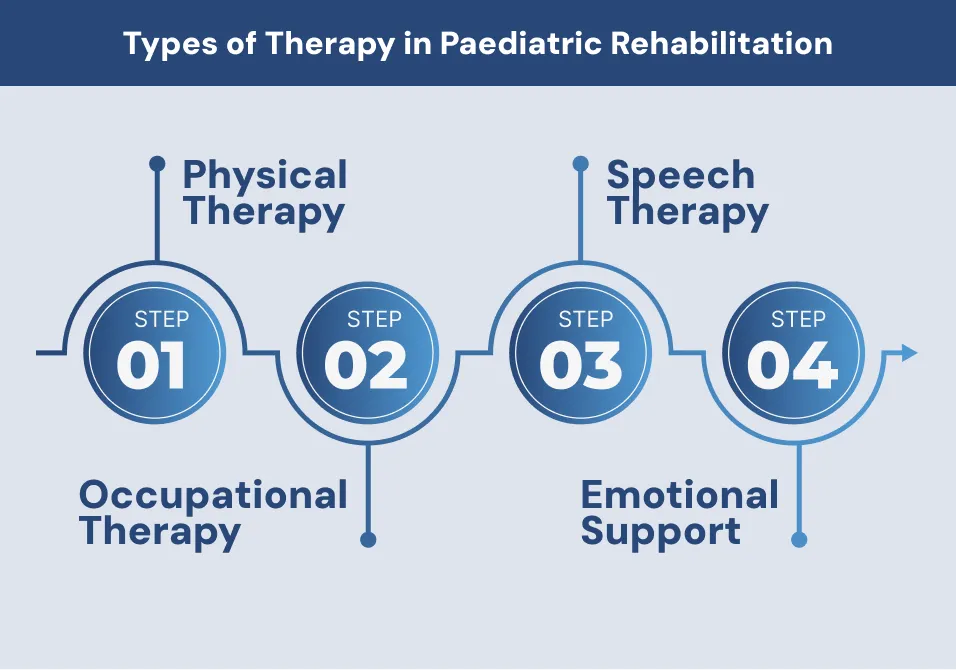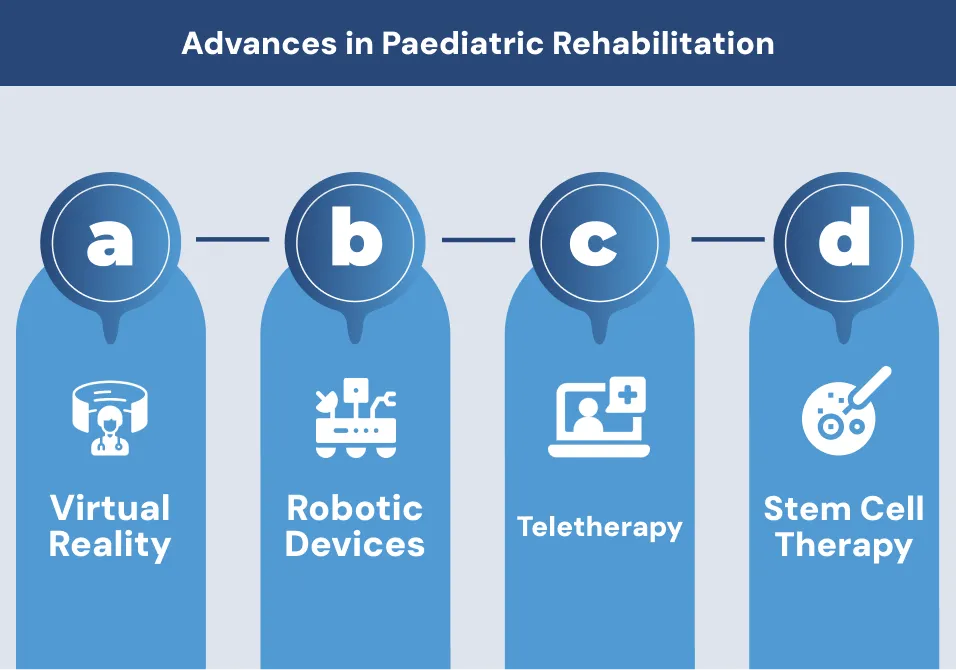Rehab helps those children with disabilities or some sort of injuries. It supports their physical and mental health. It helps children move and communicate better, and be on their own in their daily lives.
Many children across the UK need Paediatric rehabilitation every year. It gives children the tools to live active lives so that they can walk, play, speak and learn according to their age.
What is Paediatric Rehabilitation?
It is a detailed set of therapies. It aims to help children who find it hard to perform their daily activities. They might be unable to move, learn or communicate. Such issues may arise from conditions they were born with or problems that appeared later. This maybe because of some accidents or serious illness.
Children are still in the growing phase, unlike the adults. This means they need different care. Paediatric care focuses on helping the child reach their best possible abilities while also aiding in their development.
Who Needs It?
Not every child needs rehab. Children who may need this include those with:
- Cerebral palsy
- Brain injuries or strokes
- Muscle or bone disorders
- Delayed development
- Autism and sensory issues
- Speech and language difficulties
- Spinal cord injuries
- Cancer recovery
- Major surgery
These conditions may disturb the growth and overall life of a child . Rehab offers support tailored to these issues.
Types of Therapy in Paediatric Rehabilitation
It is not just one type of therapy. Usually, it is a mix of different treatments depending on what the child needs. Here are the main types used in the UK.
1. Physical Therapy
This helps children who have trouble moving their arms, legs, or whole body. It’s often used after injuries or for children with physical disabilities.
Common goals:
- Improve strength
- Help with balance and walking
- Manage pain
- Prevent muscle tightness
Physical therapists may use a number of methods. They use exercises, stretches, or even play-based activities for children. For younger kids, therapy often looks like fun games.

According to a recent article published in The Guardian,
“Children in the UK are suffering ‘irreversible harm’ and lifelong consequences as a result of ‘unacceptable’ delays in accessing physiotherapy.”
It highlights just how serious the delays in paediatric rehabilitation can be if not addressed quickly.
2. Occupational Therapy
It focuses on everyday skills. If a child struggles to dress, eat, write, or play, this therapy can help. It uses daily activities, exercises, and other therapies to remove the barriers affecting a person’s basic abilities.
Goals include:
- Teaching fine motor skills (like using fingers to pick up objects)
- Helping with feeding or self-care
- Adapting toys, tools, or home setups
- Supporting attention and focus at school
Learn more about the Role of a Child Psychologist in Family Law Cases.
3. Speech Therapy
This helps children who have trouble speaking. They may also find it hard to understand a language, or swallow food. Therapists work on their communication, both verbal and non-verbal.
Common goals:
- Helping with first words or sentences
- Teaching children how to take turns in while talking
- Supporting those children with stutters or lisps
- Improving eating and swallowing for safety
4. Emotional Support
Some children need help with managing their emotions. They may have anxiety or trauma making it harder for them.
Common Areas:
Therapy here focuses on:
- Behavioural issues
- Coping with pain or illness
- Social interaction skills
- Mental health support
Understand the Role of the Association of Child Psychotherapists in the UK.
The Situation in the UK
The NHS provides paediatric rehabilitation services in the UK. But many families are struggling to access them in time.
Challenges:
- Long waiting lists: Some children wait over a year for therapy.
- Staff shortages: There aren’t enough therapists in some areas.
- Unequal access: Services are better in some parts of the country than others.
- Lack of funding: Some child rehab centres face cuts or closures.
Despite these issues, there are also positive signs:
Improvements:
- Now in Wales, 98% of children often start therapy within 14 weeks.
- Scotland has seen a 27.5% increase in children’s physiotherapists over 10 years.
- New telehealth services allow therapy to happen at home via video calls.
Case Study: Paulina’s Remarkable Recovery — Bristol Royal Hospital for Children
A 15-year-old trampoline gymnast got her cervical spine fractured after a training accident in 2024. She also suffered a spinal cord injury. She arrived at the hospital unable to move her limbs.
Emergency spine reduction and surgery were performed within hours at Bristol Royal Hospital for Children. Surgeons used titanium plates, screws, and a cage prosthesis to reconstruct her vertebrae.
Through effective paediatric care, She began regaining sensation in her left arm; days later, feeling in her left leg returned. She took her first steps again which was remarkable for a severe cervical fracture (C5–C6). Seven months later, she completed a 10 km run and now plans to train for a half-marathon.
This case is a proof that, with the right child rehab care, children can exceed recovery expectations.
Advances in Paediatric Rehabilitation
Therapy is changing. New techniques are helping children stay motivated and improve fast.
1. Virtual Reality
Gamification of treatment can make it more interesting. Therapists use VR games to make therapy more exciting. It includes rewards, challenges, and progress tracking. In this way, children work on movement or balance while playing a game.
2. Robotic Devices
These tools help children move their arms or legs with the support of machines. It’s especially useful for children recovering from serious injuries.For example, robotic exoskeletons assist children with spinal cord injuries.
Also for cerebral palsy in walking. It is also effective for the experience of upright movement. Similarly, advanced prosthetics have allowed tailored options for children.
3. Teletherapy
It is mainly useful for the families who live far from hospitals. They can now connect with therapists online. This helps children in rural areas get the care they need.

4. Stem Cell Therapy
Stem cell therapy and regenerative medicine represent a bright hope in the child rehab trend. Especially in areas where treatment modalities remain very limited. These therapies are still experimental. But, preliminary results are promising.
Get Effective Child and Adolescent Psychiatry Expert Witness Report.
Let Us Help You
Paediatric Rehabilitation is not just about therapy sessions. It’s about helping a child smile, walk, speak, and grow with confidence. It’s about giving families hope and tools for a better future.
At Concise Medico, we provide the support you need. Our expert therapists aim to change the lives of thousands of children. When a child gets the help they need at the right time, everything becomes possible. Contact us today and explore the real power of paediatric rehabilitation.
FAQs
Rehab helps those children with disabilities or some sort of injuries. It supports their physical and mental health. It helps children move and communicate better, and be on their own in their daily lives.
Many children across the UK need Paediatric rehabilitation every year. It gives children the tools to live active lives so that they can walk, play, speak and learn according to their age.
What is Paediatric Rehabilitation?
It is a detailed set of therapies. It aims to help children who find it hard to perform their daily activities. They might be unable to move, learn or communicate. Such issues may arise from conditions they were born with or problems that appeared later. This maybe because of some accidents or serious illness.
Children are still in the growing phase, unlike the adults. This means they need different care. Paediatric care focuses on helping the child reach their best possible abilities while also aiding in their development.
Who Needs It?
Not every child needs rehab. Children who may need this include those with:
- Cerebral palsy
- Brain injuries or strokes
- Muscle or bone disorders
- Delayed development
- Autism and sensory issues
- Speech and language difficulties
- Spinal cord injuries
- Cancer recovery
- Major surgery
These conditions may disturb the growth and overall life of a child . Rehab offers support tailored to these issues.
Types of Therapy in Paediatric Rehabilitation
It is not just one type of therapy. Usually, it is a mix of different treatments depending on what the child needs. Here are the main types used in the UK.
1. Physical Therapy
This helps children who have trouble moving their arms, legs, or whole body. It’s often used after injuries or for children with physical disabilities.
Common goals:
- Improve strength
- Help with balance and walking
- Manage pain
- Prevent muscle tightness
Physical therapists may use a number of methods. They use exercises, stretches, or even play-based activities for children. For younger kids, therapy often looks like fun games.

According to a recent article published in The Guardian,
“Children in the UK are suffering ‘irreversible harm’ and lifelong consequences as a result of ‘unacceptable’ delays in accessing physiotherapy.”
It highlights just how serious the delays in paediatric rehabilitation can be if not addressed quickly.
2. Occupational Therapy
It focuses on everyday skills. If a child struggles to dress, eat, write, or play, this therapy can help. It uses daily activities, exercises, and other therapies to remove the barriers affecting a person’s basic abilities.
Goals include:
- Teaching fine motor skills (like using fingers to pick up objects)
- Helping with feeding or self-care
- Adapting toys, tools, or home setups
- Supporting attention and focus at school
Learn more about the Role of a Child Psychologist in Family Law Cases.
3. Speech Therapy
This helps children who have trouble speaking. They may also find it hard to understand a language, or swallow food. Therapists work on their communication, both verbal and non-verbal.
Common goals:
- Helping with first words or sentences
- Teaching children how to take turns in while talking
- Supporting those children with stutters or lisps
- Improving eating and swallowing for safety
4. Emotional Support
Some children need help with managing their emotions. They may have anxiety or trauma making it harder for them.
Common Areas:
Therapy here focuses on:
- Behavioural issues
- Coping with pain or illness
- Social interaction skills
- Mental health support
Understand the Role of the Association of Child Psychotherapists in the UK.
The Situation in the UK
The NHS provides paediatric rehabilitation services in the UK. But many families are struggling to access them in time.
Challenges:
- Long waiting lists: Some children wait over a year for therapy.
- Staff shortages: There aren’t enough therapists in some areas.
- Unequal access: Services are better in some parts of the country than others.
- Lack of funding: Some child rehab centres face cuts or closures.
Despite these issues, there are also positive signs:
Improvements:
- Now in Wales, 98% of children often start therapy within 14 weeks.
- Scotland has seen a 27.5% increase in children’s physiotherapists over 10 years.
- New telehealth services allow therapy to happen at home via video calls.
Case Study: Paulina’s Remarkable Recovery — Bristol Royal Hospital for Children
A 15-year-old trampoline gymnast got her cervical spine fractured after a training accident in 2024. She also suffered a spinal cord injury. She arrived at the hospital unable to move her limbs.
Emergency spine reduction and surgery were performed within hours at Bristol Royal Hospital for Children. Surgeons used titanium plates, screws, and a cage prosthesis to reconstruct her vertebrae.
Through effective paediatric care, She began regaining sensation in her left arm; days later, feeling in her left leg returned. She took her first steps again which was remarkable for a severe cervical fracture (C5–C6). Seven months later, she completed a 10 km run and now plans to train for a half-marathon.
This case is a proof that, with the right child rehab care, children can exceed recovery expectations.
Advances in Paediatric Rehabilitation
Therapy is changing. New techniques are helping children stay motivated and improve fast.
1. Virtual Reality
Gamification of treatment can make it more interesting. Therapists use VR games to make therapy more exciting. It includes rewards, challenges, and progress tracking. In this way, children work on movement or balance while playing a game.
2. Robotic Devices
These tools help children move their arms or legs with the support of machines. It’s especially useful for children recovering from serious injuries.For example, robotic exoskeletons assist children with spinal cord injuries.
Also for cerebral palsy in walking. It is also effective for the experience of upright movement. Similarly, advanced prosthetics have allowed tailored options for children.
3. Teletherapy
It is mainly useful for the families who live far from hospitals. They can now connect with therapists online. This helps children in rural areas get the care they need.

4. Stem Cell Therapy
Stem cell therapy and regenerative medicine represent a bright hope in the child rehab trend. Especially in areas where treatment modalities remain very limited. These therapies are still experimental. But, preliminary results are promising.
Get Effective Child and Adolescent Psychiatry Expert Witness Report.
Let Us Help You
Paediatric Rehabilitation is not just about therapy sessions. It’s about helping a child smile, walk, speak, and grow with confidence. It’s about giving families hope and tools for a better future.
At Concise Medico, we provide the support you need. Our expert therapists aim to change the lives of thousands of children. When a child gets the help they need at the right time, everything becomes possible. Contact us today and explore the real power of paediatric rehabilitation.



